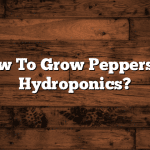Understanding the Importance of Proper Ventilation
Proper ventilation is a crucial aspect of any hydroponic garden. It plays a vital role in maintaining a favorable environment for plant growth. Adequate ventilation helps control temperature, humidity, and air quality, preventing the onset of various issues such as mold, mildew, and stagnant air.
One of the primary benefits of proper ventilation is temperature regulation. In a hydroponic setup, high temperatures can be detrimental to plant growth, leading to wilting and nutrient deficiencies. Good ventilation allows for the removal of excess heat, ensuring that the temperature remains within the optimal range. Additionally, ventilation helps to maintain consistent humidity levels, reducing the risk of diseases and pests that thrive in moist environments. Ultimately, providing proper ventilation is essential for creating an optimal growing environment in hydroponic gardens.
Calculating the CFM Requirement for Hydroponic HID Lighting
To ensure optimal growth and health of your hydroponic plants, it is critical to properly calculate the CFM (cubic feet per minute) requirement for your HID (high-intensity discharge) lighting system. CFM refers to the amount of air that needs to be exhausted from your grow space every minute. This is necessary to prevent heat build-up, regulate temperature and humidity, and maintain a well-ventilated environment.
The first step in calculating the CFM requirement is to determine the wattage of your HID lighting system. Generally, each watt of HID lighting requires approximately 0.5 – 1 CFM for adequate ventilation. However, it is important to note that this range may vary depending on factors such as grow room size, ambient temperature, and the specific type of HID lighting being used.
Once you have determined the wattage of your HID lighting system, you can then multiply it by the appropriate CFM factor to determine the total CFM requirement. For example, if you have a 1000-watt HID lighting system, you would multiply it by 0.5-1 CFM per watt, resulting in a CFM requirement of 500-1000. By accurately calculating the CFM requirement, you can select an exhaust fan that meets the specific needs of your hydroponic setup and ensure optimal air circulation for your plants’ growth and development.
Factors Affecting CFM Requirements in Hydroponics
Proper ventilation is crucial in hydroponics to maintain a healthy and thriving garden. Several factors can influence the CFM (cubic feet per minute) requirements for ventilation in a hydroponic setup. One factor to consider is the size of the grow space. Larger grow spaces will require a higher CFM to ensure sufficient air exchange and prevent heat buildup. Additionally, the type and number of plants being grown will also impact the CFM requirements. Plants that produce more heat or have high transpiration rates will need more airflow to maintain optimal growing conditions. Lastly, the ambient temperature and humidity levels in the grow area need to be taken into account, as these variables can affect the CFM requirements as well.
Another factor influencing CFM requirements in hydroponics is the type of lighting being used. HID (high-intensity discharge) lighting, such as metal halide (MH) or high-pressure sodium (HPS) lamps, produces a significant amount of heat. As a result, proper ventilation is essential to dissipate the excess heat and maintain an ideal temperature range for the plants. The wattage of the HID lights, as well as the number of fixtures, will determine the amount of heat generated and, consequently, the CFM requirements for ventilation. It is crucial to calculate the CFM needed accurately to ensure optimal air circulation and temperature control in the hydroponic garden.
Selecting the Right Exhaust Fan for Your Hydroponic Setup
When it comes to setting up a hydroponic garden, selecting the right exhaust fan is of utmost importance. A properly functioning exhaust fan plays a crucial role in maintaining the ideal growing environment for your plants. By efficiently removing stale air, excess heat, and humidity, an exhaust fan helps to prevent the build-up of harmful pathogens, mold, and mildew that could potentially damage your crops.
When choosing an exhaust fan for your hydroponic setup, there are a few key factors to consider. Firstly, you need to determine the size of the space that needs to be ventilated. The fan should have sufficient power to effectively exchange the air in the room, ensuring that fresh air is continuously brought in and stale air is expelled. Secondly, consider the noise level of the fan. Since hydroponic gardens are often set up indoors, you want to avoid selecting a fan that generates excessive noise, which could be a nuisance to you or your neighbors. Lastly, look for a fan that is durable and of high quality. Investing in a reliable exhaust fan that can withstand the demands of constant operation will save you money in the long run, as it will require fewer replacements and repairs.
Tips for Efficient Air Circulation in Hydroponic Gardens
Successful air circulation is a crucial factor for achieving optimal growth in hydroponic gardens. Adequate air movement helps to maintain consistent temperature and humidity levels, prevents the buildup of harmful pathogens, and ensures a steady supply of carbon dioxide for photosynthesis. To achieve efficient air circulation in your hydroponic setup, there are a few key tips to keep in mind.
Firstly, it is important to strategically place fans throughout your garden to promote airflow. Positioning fans at different heights and angles will help to distribute the air evenly, ensuring that every plant receives proper ventilation. Additionally, consider investing in oscillating fans that can move from side to side, creating a gentle breeze that mimics natural outdoor conditions.
Next, be mindful of the size of your grow space when choosing fans. Select fans that are powerful enough to effectively move the air in the entire room. It is recommended to opt for fans with adjustable settings so that you can control the speed and intensity of airflow according to the specific needs of your plants. Moreover, regularly clean and maintain your fans to prevent dust buildup, which can hinder their performance.
Lastly, proper intake and exhaust ventilation systems are essential components for efficient air circulation. Ensure that your intake vents are positioned near the lower portion of the grow room, allowing fresh air to enter. Meanwhile, place exhaust vents higher up in the room to facilitate the removal of stale air and maintain a constant airflow cycle.
By following these tips and paying attention to the air circulation in your hydroponic garden, you can create an optimal environment for your plants to thrive. Not only will this help to prevent issues caused by stagnant air, but it will also promote healthy growth and increased yields. Remember, effective air circulation is just as vital as proper lighting and nutrient delivery in the overall success of your hydroponic setup.






